AMD Radeon HD 7970 Review: 28nm And Graphics Core Next, Together As One
by Ryan Smith on December 22, 2011 12:00 AM EST- Posted in
- GPUs
- AMD
- Radeon
- ATI
- Radeon HD 7000
Crysis: Warhead
Kicking things off as always is Crysis: Warhead. It’s no longer the toughest game in our benchmark suite, but it’s still a technically complex game that has proven to be a very consistent benchmark. Thus even 4 years since the release of the original Crysis, “but can it run Crysis?” is still an important question, and the answer continues to be “no.” While we’re closer than ever, full Enthusiast settings at a 60fps is still beyond the grasp of a single-GPU card.
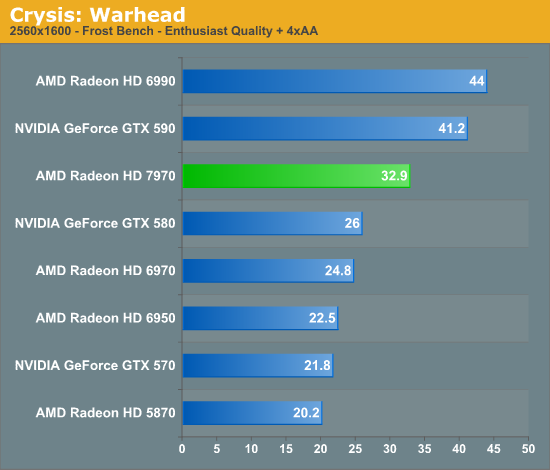

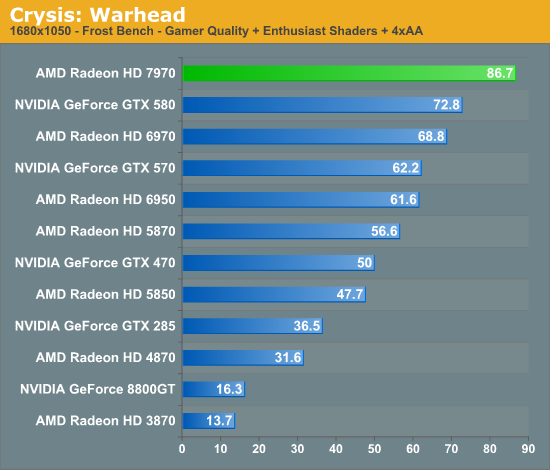
This year we’ve finally cranked our settings up to full Enthusiast quality for 2560 and 1920, so we can finally see where the bar lies. To that extent the 7970 is closer than any single-GPU card before as we’d imagine, but it’s going to take one more jump (~20%) to finally break 60fps at 1920.
Looking at the 7970 relative to other cards, there are a few specific points to look at; the GTX 580 is of course its closest competitor, but we can also see how it does compared to AMD’s previous leader, the 6970, and how far we’ve come compared to DX10 generation cards.
One thing that’s clear from the start is that the tendency for leads to scale with the resolution tested still stands. At 2560 the 7970 enjoys a 26% lead over the GTX 580, but at 1920 that’s only a 20% lead and it shrinks just a bit more to 19% at 1680. Even compared to the 6970 that trend holds, as a 32% lead is reduced to 28% and then 26%. If the 7970 needs high resolutions to really stretch its legs that will be good news for Eyefinity users, but given that most gamers are still on a single monitor it may leave AMD closer to 40nm products in performance than they’d like.
Speaking of 40nm products, both of our dual-GPU entries, the Radeon HD 6990 and GeForce GTX 590 are enjoying lofty leads over the 7970 even with the advantage of its smaller fabrication process. To catch up to those dual-GPU cards from the 6970 would require a 70%+ increase in performance, and even with a full node difference it’s clear that this is not going to happen. Not that it’s completely out of reach for the 7970 once you start looking at overclocking, but the reduction in power usage when moving from TSMC 40nm to 28nm isn’t nearly large enough to make that happen while maintaining the 6970’s power envelope. Dual-GPU owners will continue to enjoy a comfortable lead over even the 7970 for the time being, but with the 7970 being built on a 28nm process the power/temp tradeoff for those cards is even greater compared to 40nm products.
Meanwhile it’s interesting to note just how much progress we’ve made since the DX10 generation though; at 1920 the 7970 is 130% faster than the GTX 285 and 170% faster than the Radeon HD 4870. Existing users who skip a generation are a huge market for AMD and NVIDIA, and with this kind of performance they’re in a good position to finally convince those users to make the jump to DX11.
Finally it should be noted that Crysis is often a good benchmark for predicting overall performance trends, and as you will see it hasn’t let us down here. How well the 7970 performs relative to its competition will depend on the specific game, but 20-25% isn’t too far off from reality.
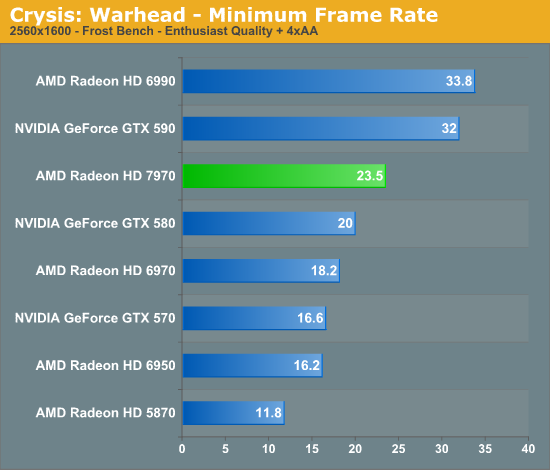
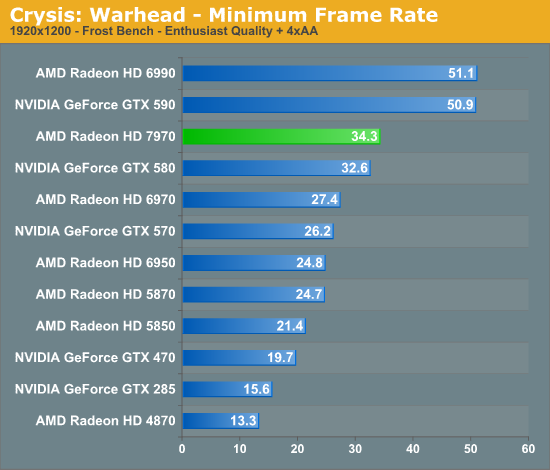
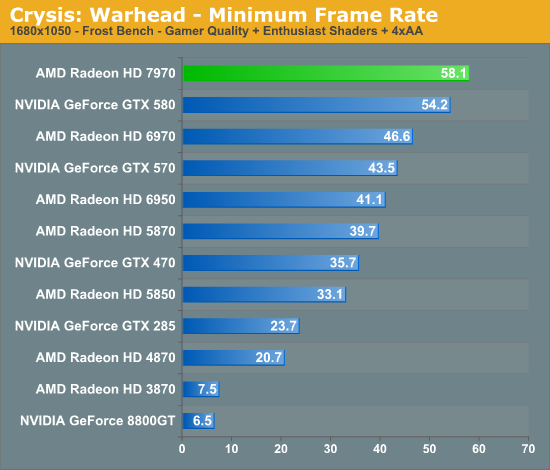
Looking at our minimum framerates it’s a bit surprising to see that while the 7970 has a clear lead when it comes to average framerates the minimums are only significantly better at 2560. At that resolution the lowest framerate for the 7970 is 23.5 versus 20 for the GTX 580, but at 1920 that becomes a 2fps, 5% difference. It’s not that the 7970 was any less smooth in playing Crysis, but in those few critical moments it looks to be dipping a bit more than the GTX 580.
Compared to the 6970 on the other hand the minimum framerate difference is much larger and much more consistent. At 2560 the 7970’s minimums are 29% better, and even at lower resolutions it holds at around 25%. Clearly even with AMD’s new architecture their designs still inherit some of the traits of their old designs.










292 Comments
View All Comments
GenSozo - Thursday, December 22, 2011 - link
Style? Another possibility is that he has no life, a heavily worn F5 key, and lots of angst.Blaster1618 - Monday, December 26, 2011 - link
One request when diving into acronyms (from the “quick refresher”), first one is followed by (definition in parenthesis) or hyperlink. Your site does the best on the web at delving into and explaining the technical evolution of computing. You maybe even able to tech the trolls and shills a thing or to they can regurgitate at there post X-mas break circle jerk. Never underestimate the importance or reach of your work.lordken - Friday, January 6, 2017 - link
mmh quite far from disappointing, still running on 7950 as of today [5 years later] :)Concillian - Thursday, December 22, 2011 - link
Page 1Power Consumption Comparison: Columns: AMD / Price / NVIDIA
Presumably mislabeled.
Anand Lal Shimpi - Thursday, December 22, 2011 - link
Fixed, thank you!Take care,
Anand
Penti - Thursday, December 22, 2011 - link
Will the new video decode engine either add software accelerated gpu or fixed function hardware WebM/VP8 video decode? ARM SoC's basically already has those capabilities with rock-chip including hw-decoding, TI OMAP IVA3 DSP-video processor supporting VP8/WebM, Broadcom supporting it in their video processor and others to come. Would be odd to be able to do smooth troublefree 1080p WebM on a phone or tablet, but not a desktop and laptop computer without taxing the cpu and buses like crazy. It's already there hardware-wise in popular devices to do if they add software/driver support for it.Nice to see a new generation card any how.
Ryan Smith - Thursday, December 22, 2011 - link
It's UVD3, the same decoder that was on Cayman. So if Cayman can't do it, Tahiti can't either.MadMan007 - Thursday, December 22, 2011 - link
Pretty sure the chart on the first page should be labeled Price Comparison not Power Consumption Comparison.Unless perhaps this was a sly way of saying money is power :)
descendency - Thursday, December 22, 2011 - link
You list the HD 6870 as 240 on the first page ("AMD GPU Specification Comparison" chart) but then list it as around 160 in the "Winter 2011 GPU Pricing Comparison" chart. 80 dollars is quite a difference.Anand Lal Shimpi - Thursday, December 22, 2011 - link
Fixed, sorry those were older numbers.Take care,
Anand